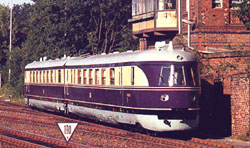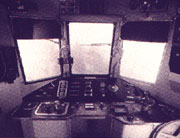| |
Epoch II
Introduction
The rise of the long-distance railroad traffic
A new era, a new generation of coaches
Standard design locomotives
Service on a high level, the Mitropa
The rise of a trainlegend
A new numbering scheme for passenger cars
Beginning of the modern age, electric locomotives
A new idea, the SVT
The competitor of the SVT, the Henschel-Wegmann-Zug
Result of renewal: the Schürzenwagen
The temporarily ending
A new idea, the SVT
 | | In orginal state restored SVT, seen here SVT 137 225 (Berlin-Wansee, 7th july 1991) |
In the thirties, Dr Dorpmöller, the president of the DRG, discovered the existence of customers who were willing to exchange the aircraft for the train, this customers were generally businessmen. The plan was to develop a network of fast connection, with speeds up to 150 km/h, between the major German cities. They developed the first trainset in 1932 for this new plan, this trainset was the VT 877 a/b "Fliegender Hamburger". The first commercial run was on the connection Berlin-Hamburg. The result was very successful and the DRG decided to order 13 trainsets of type SVT 137 149 ff. type "Hamburg". The name SVT stands for: Schnell Verbrennungs Triebszug. These trainsets were derived from the VT 877 a/b "Fliegender Hamburger". These trainsets were first entered into service on the connections: Berlin-Hamburg, Berlin-Köln, Berlin-Frankfurt/Main and Berlin-Nürnberg-München/Stuttgart. It was possible to ride with two coupled trainsets, this happened between Berlin and Nürnberg and Berlin and Hamm. On the connection Hannover-Hamm the trains reached an average speed of 132,2 km/h. With this speed the trainsets claimed the title "fastest train in the world".
Because the huge success of the SVT, seats were often weeks before reserved, therefore there was need for more seats. It turned out that doubling the power of the engines from 301 kW to 4422 kW, resulted only in a little increase of the weight. On this way they could construct three unit trainsets. The new three unit trainsets of type SVT 137 153 ff. type "Leipzig" were delivered in 1935 as two diesel electric trainsets and in 1936 as two diesel hydraulic trainsets. These trainsets of type "Leipzig" were entered into service on 15 May 1936 on the connection Berlin-Beuthen as train FDt 45/46.
 | | Cabin of SVT trainset type "Köln" |
It was true that the concept of the DRG to built up a network of fast diesel trainsets was proved, but it was not acceptable that the attraction lowered because of a couple of weaknesses. A point of critism were the salon compartments and the bar with limited Mitropa catering. New trainsets must have closed compartments and a full catering with restauration compartment. The three units, the diesel electric power and the topspeed of 160 km/h must remained the same. Because of the change of the interiors, the middle coach must lengthened, as a result they rejected the use of the Jakobs bogies. Manufacturer Linke-Hofmann-Busch in Breslau built the SVT type "Köln". Between 1936 and 1938 14 trainsets of type "Köln" with the numbers SVT 137 273 upto 278 and SVT 137 851 upto 858 entered service. These trainsets had their service on the connections Berlin-Köln, Berlin-Nürnberg-München/Stuttgart and Dortmund-Basel.
All the SVT trainsets had fast running diesel engines, but there were people in the DRG who thought that they had to use slow running diesel engines. There were a couple of experiences with that sort of engines. The advantages of this type of engine was that there was essential less abrasion, the disadvantage was that the construction was more heavier, so the engines couldn't fit anymore in a bogie, they had to use an entire power car.
M.A.N. in Nürnberg developed in 1938 a SVT with diesel electric power but with another construction as the other SVT trainsets. Instead of power cars with seats and among them coaches, the SVT "Berlin" had a seperate power car with only a luggage compartment and a post compartment. This concept can be seen as the predecessor of the ICE 2. By means of Scharfenberg couplers both middle coaches were coupled together, and on the other end of the train was a steering car with the electric driving motors. The SVT "Berlin" was actually a prototype. They built and delivered only two trainsets, the SVT 137 901 and the SVT 137 902 and a reserve powercar SVT 137 903a.
The SVT "Berlin" had never entered service because the break out of the second world war. From 1940 the service of all SVT trainsets stopped. Most SVT trainsets returned into service at the DB or the DR in the former DDR. See also Epoch III.
|
